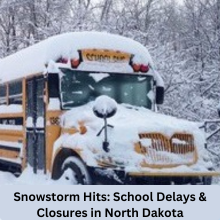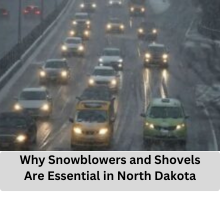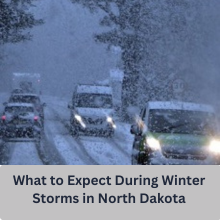
As North Dakota moves through the end of November, winter’s cold grip is slowly but surely setting in. While the weather may seem mild right now, residents across the state are bracing for the inevitable snowstorms, icy roads, and freezing temperatures. From Fargo to Grand Forks, North Dakota is gearing up for another winter season, which will no doubt bring bone-chilling cold and unpredictable weather.
One of the biggest challenges this time of year is ensuring you are well-prepared for the harsh winter conditions. With snowstorms looming, power outages possible, and roads becoming treacherous, it’s important to get ahead of the season. By starting your winter preparations early, you can avoid the stress and danger that often come with the first snowfall. Let’s take a closer look at the crucial steps every North Dakota resident should take to ensure they’re ready when winter arrives.
Understanding North Dakota’s Harsh Winter Conditions
North Dakota is known for its unpredictable and severe winter weather. Temperatures can plummet to bone-chilling lows, and heavy snowstorms can hit without much warning. As Alex Hoffman, a manager at Ace Hardware in Moorhead, explains, “It could be 3 inches one day, and 3 feet the next.” This variability is one of the reasons it’s so essential to prepare ahead of time.
In addition to heavy snowfall, strong winds and freezing temperatures often accompany winter storms. These conditions can create dangerous driving situations and make everyday tasks, like getting to work or school, challenging. Ice-covered roads and blizzard conditions are common occurrences, making it critical for everyone in the area to stay informed and ready for anything.
The Importance of Early Winter Prep
Winter can be both exciting and overwhelming, but it’s always better to be over-prepared than caught off guard. By getting your winter prep done early, you can avoid scrambling at the last minute. Whether it’s winterizing your home, checking your car, or buying essential equipment, early preparation can save you time, money, and stress.
Preparing your home is the first step. Make sure your windows are sealed properly, your heating system is working, and you have enough blankets and warm clothing for your family. Don’t forget to stock up on non-perishable food, flashlights, and batteries in case of power outages.
Equally important is getting your car ready for winter driving. This means checking your tires, ensuring your battery is in good condition, and having your car’s fluids topped off. Don’t forget to keep an ice scraper and snow brush in your car, along with a first-aid kit, blanket, and extra gloves.
Essential Winter Equipment for Your Home and Car
When it comes to winter prep, having the right equipment on hand is crucial. These are some of the must-have items for both your home and vehicle to get through the season safely.
- Snow shovels and snow blowers: A good snow shovel is essential for clearing driveways and walkways. If you live in an area that receives heavy snowfall, consider investing in a snow blower to save time and energy.
- Ice melt and salt: Keeping sidewalks and driveways clear of ice is crucial for safety. Ice melt is a simple but effective solution to prevent dangerous slip-and-fall accidents.
- Backup generators: Power outages are common during winter storms. Having a backup generator can ensure that your home stays warm and your essential appliances keep running. If you don’t have one yet, now’s the time to get it.
- Emergency kits: Always have a winter survival kit in your car. This should include water, snacks, blankets, a flashlight, and extra clothing. Additionally, make sure your car’s tires are winter-ready, and keep your windshield wipers in top condition.
Why Snowblowers and Shovels Are Essential in North Dakota
When it comes to clearing snow, the right tools can make a huge difference. North Dakota residents experience some of the harshest winters in the country, which means having an effective way to remove snow is a necessity.
Snow shovels are the classic go-to for smaller jobs, such as clearing your driveway or walkway. However, for those who live in areas that experience heavy snowfall, a snow blower is a must. Snow blowers can quickly clear large amounts of snow, saving you time and energy. Before the snow starts to fall, make sure to inspect your snow blower. Check the oil, gas, spark plugs, and skid shoes to ensure it’s ready for action.
Winter Road Safety Tips
Winter weather can quickly turn roads from safe to hazardous. As the snow begins to fall and temperatures drop, drivers should take extra precautions when hitting the road.
Know road conditions before leaving. Conditions can change rapidly, so it’s always a good idea to check road reports. The WDAY StormTRACKER app offers real-time updates on road conditions, including closures, travel alerts, and weather forecasts.
Stay safe around snowplows is also essential. Kent Leysring, a maintenance superintendent with the North Dakota Department of Transportation, advises staying back from snowplows. “Don’t crowd the plow. If we’re plowing down the interstate, we will get over if it’s safe for them to pass,” he says.
Preparing for Power Outages: Backup Plans
Winter storms are notorious for knocking out power, sometimes for extended periods. Having a backup generator is a lifesaver, especially during freezing temperatures. Backup generators can keep your home heated and your lights on when the power goes out.
Aside from a generator, it’s also wise to have alternative heat sources. Consider a portable space heater or a wood-burning stove, depending on your home’s setup. Don’t forget to check your fuel levels for these devices. In case you need to leave your home due to unsafe conditions, a winter survival kit in your car can be invaluable.
Tips for Safe Winter Driving
Driving in winter conditions can be tricky, so it’s important to adjust your driving habits to match the weather.
- Slow down: Icy roads and snow-covered surfaces can make it harder to stop. Always reduce your speed and increase the following distance.
- Keep an emergency kit in your car: Stock up on essentials such as water, snacks, blankets, and a first-aid kit.
- Use your headlights: During snowstorms, visibility can be poor. Always use your headlights, even during the day, to make sure other drivers can see you.
What to Expect During Winter Storms in North Dakota
Winter storms in North Dakota are not only disruptive but also dangerous. The National Weather Service issues winter storm warnings and weather advisories when hazardous conditions are expected. These warnings may be issued days in advance, so it’s important to stay up to date on the latest weather forecasts.
During winter storms, snow can accumulate rapidly, and winds can gust up to 30 mph, causing whiteout conditions and making travel impossible. It’s crucial to stay off the roads if conditions are too dangerous, as accidents and delays can be common during these storms.
Also read: New Study Reveals Weight Loss Drugs May Shrink Heart Muscle
Managing Snow and Wind Conditions
North Dakota’s winter storms often come with both snow and strong winds, which can reduce visibility to near zero. When this happens, it’s crucial to stay indoors. If you must go outside, make sure you are dressed warmly and take precautions against frostbite and hypothermia.
Additionally, be aware of snowdrifts caused by high winds. Snowdrifts can form quickly and make it difficult to get around, especially in rural areas.
North Dakota’s Winter Weather Outlook: What’s Ahead
This winter season, North Dakota can expect snow and cold weather to arrive early. The National Weather Service predicts significant snowfall in areas like Fargo and Grand Forks, with the potential for blizzards. Winds will likely be a factor, especially in the western and northern parts of the state.
Weather patterns are hard to predict, but residents should be prepared for the worst. According to experts, “It can change every 20 minutes, it can change every six hours,” which means checking weather reports regularly is critical.
Local Preparation Efforts in North Dakota
Cities and counties in North Dakota have their own winter preparation efforts. The North Dakota Department of Transportation has been busy maintaining snow plows and making sure that they are ready to handle whatever winter throws their way. The goal is to ensure roads are cleared as quickly as possible and that travelers stay safe.
Local governments also keep residents informed about road conditions, weather warnings, and the latest storm updates. Being proactive can help reduce the risk of accidents and delays.
Community Collaboration for Winter Safety
Winter storms can be isolating, especially for older adults or individuals with limited mobility. That’s why community collaboration is essential. Neighbors help one another by shoveling driveways, checking in on each other, and sharing resources. In times of severe weather, it’s important to look out for one another and make sure everyone stays safe.
When Winter Weather Strikes: What to Do
When severe weather strikes, the best course of action is to stay indoors. Avoid traveling unless absolutely necessary, and if you must travel, make sure your car is stocked with supplies. Stay informed with weather reports and keep in touch with family members or friends.
Also read: Experience Bhutan’s Spiritual Secrets and Ancient Festivals
Conclusion
North Dakota’s winters are challenging, but with the right preparation, you can face them head-on. From ensuring your home and car are ready to investing in the right winter equipment, early preparation is key. Remember to stay updated on weather conditions, avoid dangerous roads, and always be ready for the unpredictable. Stay safe, stay warm, and enjoy the winter season responsibly.
FAQs
-
What is the best time to prepare for winter in North Dakota?
- Start your preparations in early November to avoid the rush and ensure your home and car are ready.
-
How do I maintain my snowblower?
- Check the oil, gas, spark plugs, and skid shoes before the snow begins to fall.
-
What should I include in my car’s winter survival kit?
- Include water, snacks, a flashlight, blanket, extra clothing, and a first-aid kit.
-
How do I stay safe on icy roads?
- Slow down, increase your following distance, and use your headlights during storms.
-
What should I do if the power goes out during a storm?
- Make sure your backup generator is working, and have alternative heat sources ready.

